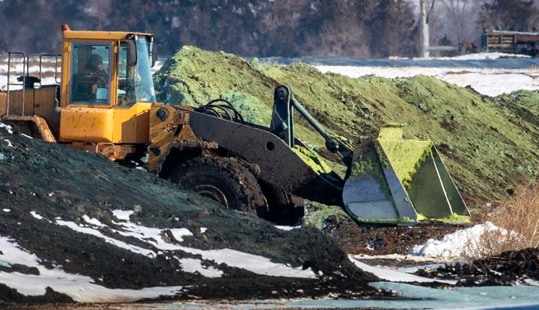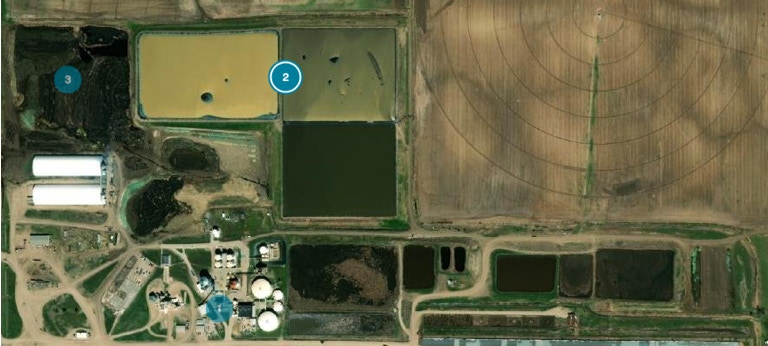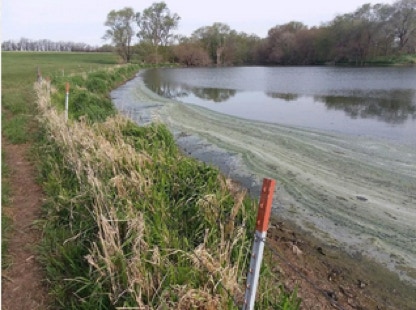AltEn Pollution
Pierce Greenberg and Caroline Adrian
Creighton University
May 20, 2021
A primer on pollution from the AltEn plant in Mead, NE
From
https://storymaps.arcgis.com/stories/ece1aa12927a49bfa8c7d23f2e6e082f
We read
Since 2015, residents in Mead, Nebraska have raised concerns about the human health and environmental impacts of a nearby ethanol facility called AltEn. The facility produces ethanol using agricultural seeds that are pre-treated with pesticides to assist with fertilization and growth. At one time, AltEn claimed to receive 98 percent of excess treated seed in the country. This includes seeds produced by Bayer U.S., Corteva Agriscience, Syngenta Seeds, AgReliant Genetics, Beck's Superior Hybrids, and Winfield Solutions. But the ethanol production process, when applied to treated seed, creates waste laced with chemicals that researchers [fear] may be harmful to people, animals, and the environment.
The two primary concerns are toxic distiller's grain or "wetcake"
and wastewater lagoons that are located on the AltEn site. The state tested both byproducts and found unsafe levels of pesticides in 2019. But AltEn has ignored orders to properly dispose of the waste, according to a lawsuit filed by the state of Nebraska against the facility in 2021. The state's complaint highlights concerns related to solid waste disposal, water pollution, and air pollution that could be impacting the human, environmental, and agricultural health of the surrounding area.
The risk associated with improper storage of waste was realized in February 2021 when a spill of more than four million gallons of wastewater impacted local properties up to four and a half miles downstream. As the maps below highlight, the AltEn site drains into the Platte River via local streams and creeks. The University of Nebraska Medical Center has formed a team to conduct a 10-year study of the human and environmental impacts of AltEn.
AltEn began the process of using treated seeds around 2015. The AltEn ethanol facility produced 24 million gallons of ethanol per year, according to a legal complaint filed against the facility by the state of Nebraska. The village of Mead, which is partially responsible for the site due to the annexation, revoked AltEn's conditional use permit in May 2021.
These three lagoons hold 176 million gallons of wastewater. The wastewater--also known as thin stillage--can be applied to agricultural land when produced from untreated seed. But the state prohibited AltEn from this practice after testing in 2019 revealed levels of pesticides thousands of times greater than EPA recommended levels. A lawsuit filed by the state claims that AltEn may have continued this practice after being ordered to stop. While the lagoons are lined, torn pieces of the liner can be seen in this satellite imagery.
Dr. Judy Wu-Smart maintained several bee colonies on this land south of AltEn. She began to notice die-offs in 2017, and since then, all of the colonies she was researching have died. Read more about her research here and here.
Her main concern surrounds neonicotinoids (or "neonics") which are a class of insecticides present in treated seed. These chemicals have also been found to have impacts on human health.
Dr. John Schalles at Creighton University has identified several flow paths from the site lagoons that lead to the Platte River. This path, outlined in red, is one potential route that contamination in water from the site could follow.
A pond at the Keiser farm lies along the flowpath between AltEn and the Platte River. The family recently requested NDEE† testing after a large fish kill in the pond. Test results from March found levels of pesticides and fungicides in the water that exceeds EPA guidelines.
After the Keiser pond, the creeks from the site drain into Clear Creek which eventually reaches the Platte River near Ashland. The water source and treatment center for the city of Lincoln's drinking water is nearby. The concern about potential water impacts from the plant were magnified after a spill of four million gallons on Feb. 21, 2021. Local environmental advocates collected this drone footage from the AltEn site.
† NDEE: Nebraska Department of Environment and Energy
This Just In
Partly from
https://nebraska.tv/news/local/mead-community-rocked-by-second-alten-spill-amid-clean-up-and-heavy-rains
we read:
December 28, 2021
This was in the paper today..
Researchers Call On NDEE
For Urgent AltEn Response
By Sam Crisler
MEAD – As cleanup continues at the AltEn plant south of Mead, environmental researchers say threats of further disaster are not going away, but instead could be continuing to develop. If such threats are allowed to fester, they could have additional harmful effects on cleanup crews, area residents and nearby groundwater.
Most recently, the AltEn Facility Response Group (AFRG) – which is led by the seed companies who sent their unused treated seeds to AltEn to be used in ethanol production – has had its focus on construction of an emergency lagoon to contain wastewater as part of its efforts to winterize the plant’s storage tanks. The tanks have been used onsite since last summer to lower the levels in the existing lagoons, which have caused concerns regarding their ability to keep wastewater contained.
At least two containment berms surrounding the AltEn plant were breached following heavy rain on Tuesday.
According to the Perivallon Group (PG), containment berms surrounding the plant’s pesticide-laden wet cake piles were breached due to a storm system dropping four inches of rain in the Mead, Nebraska area.
The Perivallon Group is a coalition of individuals that have come together to investigate the unfolding environmental disaster in Mead, Nebraska, and seek effective, meaningful change in Nebraska’s environmental laws.
Mead Village Board Chairman Bill Thorson said while citizens want the cleanup to move quickly, they’ll have to be patient [instead].
“We’re probably looking at years,” he said. “And that’s just what they know they have for contamination. The lagoons have been leaking all this time, and they don’t know the extent of that contamination yet.”
A newer development has been the formation of “whales,” or bubbles of gases that formed and continued to expand in multiple lagoons underneath the lagoon liners. The whales are clearly visible in aerial photos and contain high levels of toxic methane and hydrogen sulfide gases. According to the Nebraska Department of Environment and Energy, the AFRG has been at work depressurizing these whales for about a month.
Dr. John Schalles, a biology professor at Creighton University and a member of the AltEn-investigating Perivallon Group, said [ ] tears in the liners could be harmful to the groundwater below, and if the whales were able to continue expanding, the potential consequences could be destructive.
“Not only could there be an explosive shockwave, but it could discharge a whole lot of pesticide material that’s in [the] waste below the liner in volatile forms that would [would be harmful] to breathe,” he said.
The whales are [are being processed by] using pipes that vacuum the gases into a burner unit that (in theory) breaks down the gases into less harmful chemicals.
However, Schalles has been trying to bring attention to the possibility [that this process could create] extremely toxic compounds [because] the gases [are] not being completely broken down.
“One of the concerns we have is about the other materials that are in volatile form that have been part of this not only explosive but toxic gas mixture,” he said. “And will the burning off of those gases cause other problems? If you had substrates, i.e. these pesticides, that were heated to a higher temperature but not completely broken down, that’s a potential recipe to create what we know as dioxins.”
He said dioxins are some of the most toxic known substances [known to man]. If they were produced, they could flare into the air and create a major public health concern, he said.
Schalles said [that] bringing attention to the potential production of dioxins is not [intended] to create a panic; rather, he hopes NDEE and the AFRG will take precautions to ensure dioxins are not present.
“We don’t believe, or at least there was no evidence, that (the AFRG) had much more sophisticated analysis capabilities for the pesticides themselves, let alone dioxins,” Schalles said. “So we think it would be very wise to have those gas products from the flaring analyzed just to be sure that this hasn’t happened.”
Another concern is runoff from pesticide-laden wet cake piles, which local researchers say has continued making its way into drainage systems around the AltEn facility. Janece Mollhoff, who spearheaded a wellhead protection plan in Ashland when she was a member of the city council there, has noted that NDEE is still identifying ammonia and pesticides in the culverts along County Road 9. Mollhoff said she wants to see NDEE taking more action to mitigate the flow of compounds away from AltEn.
“The danger is, wherever it pools, then it soaks into the groundwater,” Mollhoff said. “And working on the Wellhead Protection Area in Ashland, we know that all the water from (AltEn), whether it’s groundwater or surface water, it moves down toward Ashland.”
Earlier this year, AltEn sold the neighboring Mead Cattle Company, which is still in operation, and Mollhoff said NDEE testing has found high amounts of nitrates in the wells on site. But she doesn’t think NDEE is adequately holding AltEn and Mead Cattle Company accountable or is moving forward with litigation against AltEn in a timely manner.
“Once again, NDEE is threatening fines, but as we have seen, there are no teeth behind this threat, since the Nebraska Attorney General has not pursued action on the lawsuit already filed,” Mollhoff said in an email.
NDEE was contacted for this story, but they said they are not fielding media questions at this time due to the pending litigation. They advise that people with questions visit the AltEn information page on the NDEE website.
“Once they contaminate the groundwater, (NDEE) doesn’t seem to have any requirements for them to clean it up,” Mollhoff said. “They just wait for it to flow downstream, I guess.”
NDEE was scheduled to meet with leaders in the Mead community on Wednesday, Dec. 15, but the meeting was postponed because of power outages resulting from storms that day.
Mollhoff wants to see more transparency from NDEE about updates on the cleanup process. Currently, NDEE public information comes from the meetings in Mead and updates on their website.
Thorson said Mead citizens just want to know that progress is being made.
“When people have seen the magnitude of what’s out there, they realize it’s going to take a long time,” he said. “But I think they just want to know that it’s being done, and they’re moving forward on it.”
###



